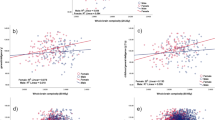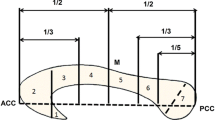Abstract
Three groups of male and female subjects (aneuploid, sterile, and fertile) were administered tests of field dependence (RFT, EFT, BDT, ABCT), spatial ability (S1, VZ1, IBT), right-left discrimination, and verbal ability. Statistical analyses indicated that (1) aneuploid males, with karyotype 47,XXY, do not disclose significant differences in field dependence or spatial abilities from karyotypically normal males or females, (2) aneuploid Turner and Turner-like females do exhibit a significantly higher field dependence and lower spatial orientation and visualization ability than other females, and (3) psychological distress caused by sterility does not seem to influence the cognitive pattern. The importance of socializing environment and hormonal factors in determining the observed differences is briefly discussed in the light of these results, and it is concluded that sex chromosome heterochromatin must play a role in the development of specific cognitive traits.
Similar content being viewed by others
References
Alexander, D., and Money, J. (1965). Reading ability, object constancy and Turner's syndrome.Percept. Mot. Skills 20:918–934.
Alexander, D., Walker, H. T., Jr., and Money, J. (1964). Studies in direction sense. I. Turner's syndrome.Arch. Gen. Psychiat. 10:337–339.
Baker, J. W., and Ehrhardt, A. A. (1974). Prenatal androgen, intelligence, and cognitive sex differences. In Friedman, R. C., Richart, R. M., and Vande Wiele, R. L. (eds.),Sex Differences in Behavior, Wiley, New York, pp. 53–76.
Benton, A. L. (1959).Right-Left Discrimination and Finger Localisation, P. Hoelber, N.J.
Bock, R. D., and Kolakowski, D. (1973). Further evidence of sex-linked major gene influence on human spatial visualizing ability.Am. J. Hum. Genet. 25:1–14.
Cohen, J. (1957). A factor analitically based rationale for the Wechsler Adult Intelligence Scale.J. Consult. Psychol. 21:451–457.
Cohen, J. (1959). The factorial structure of the WISC at the ages 7–6, 10–6, and 13–6.J. Consult. Psychol. 23:285–299.
Dawson, J. L. M. (1972). Effects of sex hormones on cognitive style in rats and men.Behav. Genet. 2:21–42.
Ehrhardt, A. A., and Baker, J. M. (1974). Fetal androgen, human central nervosus system differentiation, and behavior sex differences. In Friedman, R. C., Richart, R. M., and Vande Wiele, R. L. (eds.),Sex Differences in Behavior, Wiley, New York, pp. 33–51.
Ehrhardt, A. A., Greenberg, N., and Money, J. (1970). Female gender identity and absence of fetal gonadal hormones: Turner's syndrome.Hopkins Med. J. 126:237–248.
French, J. W., Ekstrom, R. B., and Price, L. A. (1963).Kit of Reference Tests for Cognitive Factors, Educational Testing Service, Princeton, N.J.
Garron, D. C. (1970). Sex-linked, recessive inheritance of spatial and numerical abilities and Turner's syndrome.Psychol. Rev. 77:147–152.
Garron, D. C., and Van der Stoep, L. R. (1969). Personality and intelligence in Turner's syndrome: A critical review.Arch. Gen. Psychiat. 21:339–346.
Garron, D. C., Molander, L., Cronholm, B., and Lindsten, J. (1973). An explanation of the apparently increased incidence of moderate mental retardation in Turner's syndrome.Behav. Genet. 3:37–43.
Goodenough, D. R., and Karp, S. A. (1961). Field dependence and intellectual functioning.J. Abnorm. Soc. Psychol. 63:241–246.
Goodenough, D. R., Gandini, E., Olkin, I., Pizzamiglio, L., Thayer, D., and Witkin, H. A. (1977). A study of X-chromosome linkage with field dependence and spatial visualization.Behav. Genet. 7:373–382.
Gordon, R. R., and O'Neill, E. M. (1969). Turner's infantile phenotype.Br. Med. J. 1: 483–487.
Gorski, R. A. (1971). Gonadal hormones and the perinatal development of neuroendocrine function. In Martini, L., and Ganong, W. F. (eds.),Frontiers in Neuroendocrinology, Oxford University Press, New York, p. 237.
Guttman, R. (1974). Genetic analysis of analytical spatial ability: Raven's Progressive Matrices.Behav. Genet. 4:273–284.
Hartlage, L. C. (1970). Sex-linked inheritance of spatial ability.Percept. Mot. Skills 31:610.
Lyon, M. F. (1971). Possible mechanisms of X-chromosome inactivation.Nature New Biol. 232:229–232.
Maccoby, E. E., and Jacklin, C. N. (1972). Sex differences in intellectual functioning. InAssessment in a Pluralistic Society. Proceedings of the 1972 Invitational Conference on Testing Problems, E.T.S., pp. 37–55.
Mittwoch, U. (1973).Genetics of Sex Differentiation, Academic Press, New York.
Money, J. (1963). Cytogenetic and psychosexual incongruities with a note on space-form blindness.Am. J. Psychiat. 119:820–827.
Money, J. (1964). Two cytogenetic syndromes: Psychologic comparisons. I. Intelligence and specific factor quotients.J. Psychiat. Res. 2:223–234.
Money, J. (1965). Psychosexual differentiation. In Money, J. (ed.),Sex Research: New Developments, Holt, Rinehart and Winston, New York.
Money, J., and Alexander, D. (1966). Turner's syndrome: Further demonstration of the presence of specific cognitional deficiencies.J. Med. Genet. 3:47–48.
Money, J., and Mittenthal, S. (1970). Lack of personality pathology in Turner's syndrome: Relation to cytogenetics, hormones and physique.Behav. Genet. 1:43–56.
Neuwirth, J., Starka, L., and Raboch, J. (1972). Different chromosome variants of Klinefelter syndrome and plasma testosterone.Humangenetik 15:93–95.
Nielsen, J., Sørensen, A., Theilgaard, A., Frøland, A., and Johnsen, S. G. (1969). A psychiatric-psychological study of 50 severely hypogonadal male patients, including 34 with Klinefelter's syndrome, 47,XXY.Acta Jutlandica 41:3.
Ohno, S. (1967).Sex Chromosomes and Sex-Linked Genes, Springer-Verlag, Berlin.
Ohno, S. (1974). Conservation of ancient linkage groups in evolution and some insight into the genetic regulatory mechanism of X-inactivation.Cold Spring Harbor Symp. Quant. Biol. 38:155–164.
Phoenix, C. E. (1974). Prenatal testosterone in the nonhuman primate and its consequences for behavior. In Friedman, R. L., Richart, R. M., and Vande Wiele, R. L. (eds.),Sex Differences in Behavior, Wiley, New York, pp. 19–32.
Shaffer, J. (1962). A specific cognitive deficit observed in gonadal aplasia. (Turner's syndrome).J. Clin. Psychol. 18:403–406.
Shapiro, B. H., Goldmann, A. S., Bongiovanni, A. M., and Marino, J. M. (1976). Neonatal progesterone and feminine sexual development.Nature 264:795–796.
Singh, R. P., and Carr, D. H. (1966). The anatomy and histology of XO human embryos and fetuses.Anat. Rec. 155:369–383.
Stafford, R. E. (1961). Sex differences in spatial visualization as evidence of sex-linked inheritance.Percept. Mot. Skills 13:428–435.
Theilgaard, A., Nielsen, J., Sørensen, A., and Frøland, A., and Hohnsen, S. G. (1971). A psychological-psychiatric study of patients with Klinefelter's syndrome, 47,XXY.Acta Jutlandica 43:1.
Thurstone, L. L. and Thurstone, T. G. (1974).SRA Primary Mental Abilities, Science Research Associates. Chicago.
Vandenberg, S. G. (1962). The hereditary abilities study: Heredity components in a psychological test battery.Am. J. Hum. Genet. 14:220–237.
Vandenberg, S. G. (1969). A twin study of spatial ability.Multiv. Behav. Res. 4:273–294.
Waber, D. P. (1976). Sex differences in cognition: A function of maturation rate?Science 192:572–578.
Ward, J. L. (1974). Sexual behavior differentiation: Prenatal hormonal and environmental control. In Friedman, R. C., Richart, R. M., and Vande Wiele, R. L. (eds.),Sex Differences in Behavior, Wiley, New York, pp. 3–17.
Witkin, H. A., Dyk, R. B., Faterson, M. F., Goodenough, D. R., and Karp, S. A. (1962).Psychological Differentiation, Wiley, New York.
Witkin, H. A., Oltman, P. K., Raskin, E., and Karp, S. A. (1971).Manual of Embedded Figures Test, Children's EFT and Group EFT, Consulting Psychologists Press, Palo Alto, Calif.
Young, W. C., Goy, R. W., and Phoenix, C. E. (1964). Hormones and sexual behavior.Science 143:212–218.
Author information
Authors and Affiliations
Rights and permissions
About this article
Cite this article
Serra, A., Pizzamiglio, L., Boari, A. et al. A comparative study of cognitive traits in human sex chromosome aneuploids and sterile and fertile euploids. Behav Genet 8, 143–154 (1978). https://doi.org/10.1007/BF01066871
Received:
Accepted:
Issue Date:
DOI: https://doi.org/10.1007/BF01066871




